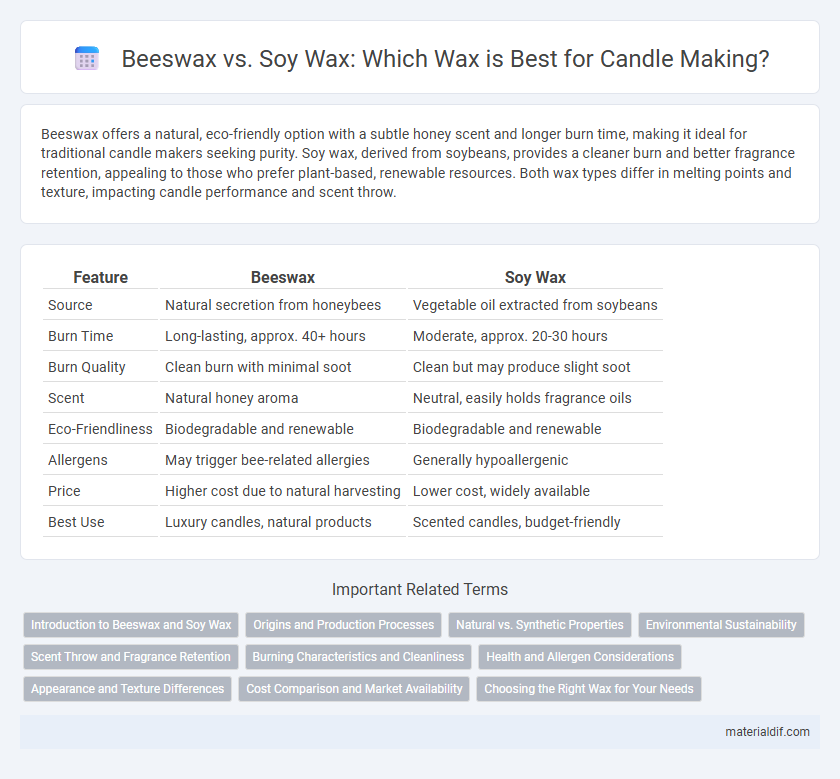Beeswax offers a natural, eco-friendly option with a subtle honey scent and longer burn time, making it ideal for traditional candle makers seeking purity. Soy wax, derived from soybeans, provides a cleaner burn and better fragrance retention, appealing to those who prefer plant-based, renewable resources. Both wax types differ in melting points and texture, impacting candle performance and scent throw.
Table of Comparison
| Feature | Beeswax | Soy Wax |
|---|---|---|
| Source | Natural secretion from honeybees | Vegetable oil extracted from soybeans |
| Burn Time | Long-lasting, approx. 40+ hours | Moderate, approx. 20-30 hours |
| Burn Quality | Clean burn with minimal soot | Clean but may produce slight soot |
| Scent | Natural honey aroma | Neutral, easily holds fragrance oils |
| Eco-Friendliness | Biodegradable and renewable | Biodegradable and renewable |
| Allergens | May trigger bee-related allergies | Generally hypoallergenic |
| Price | Higher cost due to natural harvesting | Lower cost, widely available |
| Best Use | Luxury candles, natural products | Scented candles, budget-friendly |
Introduction to Beeswax and Soy Wax
Beeswax is a natural wax produced by honeybees, known for its unique honey scent and high melting point, making it ideal for long-lasting candles. Soy wax, derived from soybean oil, offers a cleaner burn with minimal soot and is a popular eco-friendly alternative. Both waxes are renewable resources, but beeswax contains natural antibacterial properties while soy wax provides a more affordable and easily customizable option.
Origins and Production Processes
Beeswax is a natural product secreted by honeybees from their abdominal glands and collected from honeycomb cells, harvested primarily through sustainable beekeeping practices. Soy wax originates from hydrogenated soybean oil derived from soybeans, involving a complex industrial process including extraction, refining, and hydrogenation to create a clean-burning wax. While beeswax production depends on ecological balance and bee health, soy wax manufacturing leverages agricultural crops and advanced chemical treatments.
Natural vs. Synthetic Properties
Beeswax is a natural, sustainable wax produced by honeybees, known for its clean burn, hypoallergenic properties, and subtle honey scent, making it ideal for eco-conscious candle makers. Soy wax, derived from hydrogenated soybean oil, is a plant-based, renewable resource with a lower melting point and a smoother finish but often contains additives or synthetic fragrances to enhance performance. Both waxes offer eco-friendly alternatives to paraffin; however, beeswax is prized for its purity and natural complex hydrocarbons, while soy wax provides a cost-effective, vegan-friendly option with more consistent texture and scent throw.
Environmental Sustainability
Beeswax is a natural, biodegradable product harvested from beehives, supporting pollinator populations and promoting biodiversity. Soy wax, derived from soybean oil, is a renewable resource that requires agricultural inputs like water and pesticides, which can impact ecosystems if not managed sustainably. Choosing between beeswax and soy wax for candles depends on the ecological consequences of harvesting methods and land use associated with each wax type.
Scent Throw and Fragrance Retention
Beeswax offers a natural, subtle scent throw with excellent fragrance retention due to its dense composition and natural compounds that bind essential oils effectively. Soy wax provides a stronger initial scent throw, making it ideal for fragranced candles, but its lighter matrix can lead to quicker fragrance dissipation compared to beeswax. When comparing scent throw and fragrance retention, beeswax maintains a steady aroma release over an extended burn time, whereas soy wax delivers a more intense but shorter-lived fragrance experience.
Burning Characteristics and Cleanliness
Beeswax burns longer and produces a brighter, warmer flame compared to soy wax, enhancing ambiance with its natural honey scent. Soy wax typically burns cooler and slower but can emit more soot, potentially affecting indoor air quality. Both waxes offer clean-burning properties, yet beeswax's minimal smoke and drip-free burn make it superior for maintaining a cleaner environment.
Health and Allergen Considerations
Beeswax is a natural substance produced by honeybees, known for its hypoallergenic properties and ability to purify the air by releasing negative ions, making it suitable for sensitive individuals. Soy wax, derived from soybean oil, is generally safe but can cause allergic reactions in people with soy allergies, requiring caution. Both waxes burn cleanly, but beeswax has a longer burn time and emits fewer toxins, enhancing its appeal for health-conscious candle users.
Appearance and Texture Differences
Beeswax has a natural golden color with a firm, slightly sticky texture that becomes pliable when warmed, making it ideal for molding and sculpting candles. Soy wax typically appears creamy white and has a smooth, softer consistency that melts evenly, producing a cleaner burn. The contrasting appearances and textures influence the aesthetic and functional qualities of candles made from each wax type.
Cost Comparison and Market Availability
Beeswax generally costs more than soy wax due to its natural harvesting process and limited supply, with prices often ranging from $6 to $10 per pound compared to soy wax's $3 to $5 per pound. Soy wax benefits from large-scale agricultural production of soybeans, making it more widely available and affordable in mass markets. Market availability shows soy wax dominating candle-making industries and retail sectors, while beeswax remains favored in niche, premium, or artisanal products.
Choosing the Right Wax for Your Needs
Beeswax offers a natural, long-lasting burn and emits a subtle honey scent, making it ideal for those seeking an eco-friendly, aromatic candle option. Soy wax, derived from soybean oil, provides a cleaner burn with less soot and is favored for its affordability and ease of scent customization. Selecting between beeswax and soy wax depends on priorities such as environmental impact, fragrance intensity, and budget preferences.
Beeswax vs Soy Wax Infographic

 materialdif.com
materialdif.com